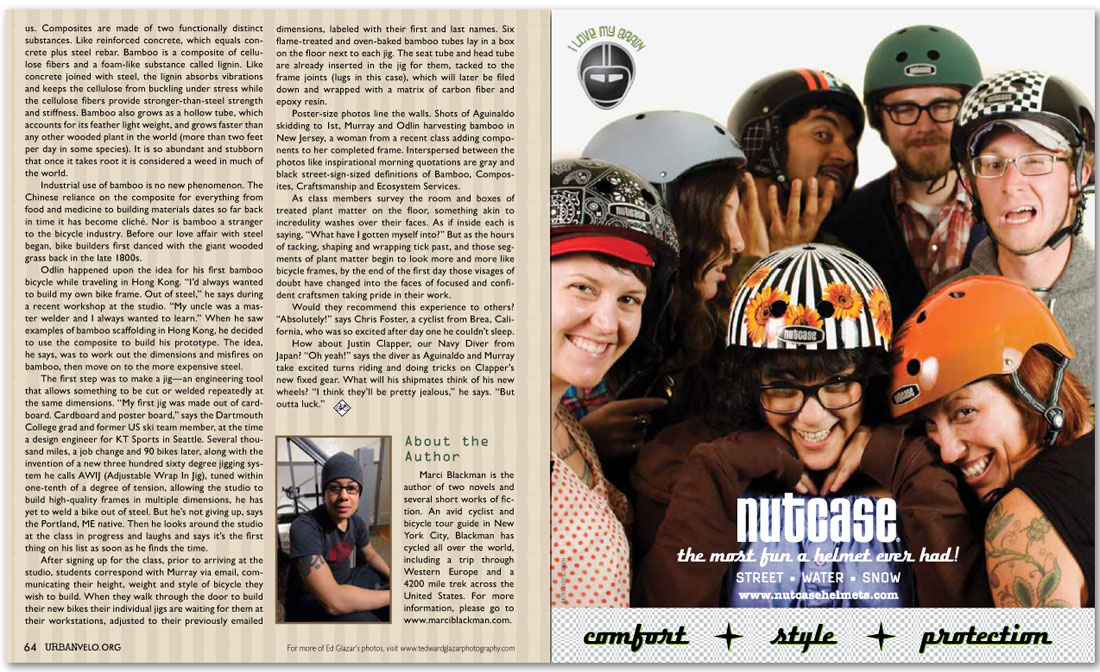


us. Composites are made of two functionally distinct substances. Like reinforced concrete, which equals concrete plus steel rebar. Bamboo is a composite of cellulose fibers and a foam-like substance called lignin. Like concrete joined with steel, the lignin absorbs vibrations and keeps the cellulose from buckling under stress while the cellulose fibers provide stronger-than-steel strength and stiffness. Bamboo also grows as a hollow tube, which accounts for its feather light weight, and grows faster than any other wooded plant in the world (more than two feet per day in some species). It is so abundant and stubborn that once it takes root it is considered a weed in much of the world.
Industrial use of bamboo is no new phenomenon. The Chinese reliance on the composite for everything from food and medicine to building materials dates so far back in time it has become cliché. Nor is bamboo a stranger to the bicycle industry. Before our love affair with steel began, bike builders first danced with the giant wooded grass back in the late 1800s.
Odlin happened upon the idea for his first bamboo bicycle while traveling in Hong Kong. “I’d always wanted to build my own bike frame. Out of steel,” he says during a recent workshop at the studio. “My uncle was a master welder and I always wanted to learn.” When he saw examples of bamboo scaffolding in Hong Kong, he decided to use the composite to build his prototype. The idea, he says, was to work out the dimensions and misfires on bamboo, then move on to the more expensive steel.
The first step was to make a jig—an engineering tool that allows something to be cut or welded repeatedly at the same dimensions. “My first jig was made out of cardboard. Cardboard and poster board,” says the Dartmouth College grad and former US ski team member, at the time a design engineer for KT Sports in Seattle. Several thousand miles, a job change and 90 bikes later, along with the invention of a new three hundred sixty degree jigging system he calls AWIJ (Adjustable Wrap In Jig), tuned within one-tenth of a degree of tension, allowing the studio to build high-quality frames in multiple dimensions, he has yet to weld a bike out of steel. But he’s not giving up, says the Portland, ME native. Then he looks around the studio at the class in progress and laughs and says it’s the first thing on his list as soon as he finds the time.
After signing up for the class, prior to arriving at the studio, students correspond with Murray via email, communicating their height, weight and style of bicycle they wish to build. When they walk through the door to build their new bikes their individual jigs are waiting for them at their workstations, adjusted to their previously emailed dimensions, labeled with their first and last names. Six flame-treated and oven-baked bamboo tubes lay in a box on the floor next to each jig. The seat tube and head tube are already inserted in the jig for them, tacked to the frame joints (lugs in this case), which will later be filed down and wrapped with a matrix of carbon fiber and epoxy resin.
Poster-size photos line the walls. Shots of Aguinaldo skidding to 1st, Murray and Odlin harvesting bamboo in New Jersey, a woman from a recent class adding components to her completed frame. Interspersed between the photos like inspirational morning quotations are gray and black street-sign-sized definitions of Bamboo, Composites, Craftsmanship and Ecosystem Services.
As class members survey the room and boxes of treated plant matter on the floor, something akin to incredulity washes over their faces. As if inside each is saying, “What have I gotten myself into?” But as the hours of tacking, shaping and wrapping tick past, and those segments of plant matter begin to look more and more like bicycle frames, by the end of the first day those visages of doubt have changed into the faces of focused and confident craftsmen taking pride in their work.
Would they recommend this experience to others? “Absolutely!” says Chris Foster, a cyclist from Brea, California, who was so excited after day one he couldn’t sleep.
How about Justin Clapper, our Navy Diver from Japan? “Oh yeah!” says the diver as Aguinaldo and Murray take excited turns riding and doing tricks on Clapper’s new fixed gear. What will his shipmates think of his new wheels? “I think they’ll be pretty jealous,” he says. “But outta luck.”
About the Author Marci Blackman is the author of two novels and several short works of fiction. An avid cyclist and bicycle tour guide in New York City, Blackman has cycled all over the world, including a trip through Western Europe and a 4200 mile trek across the United States. For more information, please go to www.marciblackman.com.
For more of Ed Glazar’s photos, visit www.tedwardglazarphotography.com